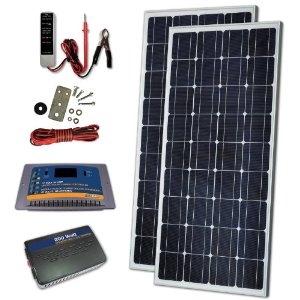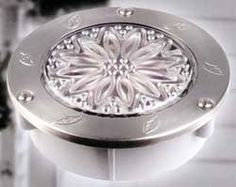Sunforce 60032 30 Amp Digital Charge Controller
Sunforce 60032 30 Amp Digital Charge Controller
- Charge controller prevents overcharging of 12-volt batteries
- Intended for use with 12-volt solar panels
- Handles up to 30 amps of array current and up to 500 watts of solar power
- Continuously display the charging current or battery voltage on the LCD digital meter
- Automatically indicates the charged condition of your battery on the LED bar graph
The Sunforce 60032 30 Amp Digital Charge Controller prevents overcharging of 12-volt batteries. It is intended for use with 12-volt solar panels, and can handle up to 30 amps of array current and up to 500 watts of solar power. The controller will continuously display the charging current or battery voltage on the LCD digital meter, and also automatically indicates the charged condition of your battery on the LED bar graph. The 60032 is designed to work with all kinds of 12-volt solar panels for indoor use.
List Price: $ 129.99
Price: $ 83.23





The two types of charge controllers / what is MPPT?,
If you’ve read the reviews, by now the acronym MPPT has shown up more than once. If you know what that means, read no further as this is not too entertaining. If you would like to know the difference in MPPT and non-MPPT solar regulators, and can tolerate some basic math or skim through it, read on and I can explain why this non-MPPT regulator will do the job, just not the BEST job possible.
MPPT stands for Maximum Power Point Tracking, which sounds like a good thing, and it definitly is a must for large house size systems, but what exactly is it? Simply put MPPT finds YOUR solar array’s Maximum amount of power for a given condition (full sun/overcast/panel tilt). It is always searching for the best voltage and current conditions to maximize power from the panels, which after all is what you paid big bucks for, right?
Let’s explore how MPPT works. Normal power regulators like this one interface between the solar panel array and the storage battery. When the battery is full, they quit charging to protect the battery from boiling the electrolyte away. Pretty simple. But what if you need more power from your solar panels than the simple case? It turns out that MPPT can, using more electronics and some intelligence, harness more power from your solar arrays than a simple on/off charge regulator. How? by using a small IC chip that searches for the highest POWER from the panel, hence the name maximum power point tracking. The tracking just means that as the sunlight changes, so does the maximum power location.
Unfortunately Solar Panels are not just a source of simple DC power – that is they don’t behave like a battery does. The fewer amps you draw from the panel, the higher the panel’s voltage across the wires becomes. This is where most MPPT discussions end but with a couple simple equations (ohm’s law) we can dive deeper into what MPPT does and why its good (and costs more).
Ohms law is really simple: there are two parts: Voltage = Current times Resistance (V=I x R)
Of course we can re-arrange it other ways: R = I/V, I = V/R Where I is in amps, V in volts, R in ohms. If we connect a 1 ohm (R) resistor across a 12V battery (V) then solving for I must be 12 AMPs flowing through the resistor.
For POWER (one P in MPPT) we need to know another simple equation Power = Volts x Amps (DC version)
In the above example, the resistor is most likely a power resistor (i.e. big) because 12 volts x 12 amps = 144 watts which gets hot real fast. In this case, the 144 watts is a power point from a battery. They are simple since small currents do not make large swings on the battery voltage and we can assume it to be nearly constant when using large storage batteries. Solar panels are quite the opposite – their voltage changes with current change. With power being the multiplier of voltage and current, you can see how this function can be maximized, which is the aim of a MPPT tracker. So how do they work this magic? read on….
Finally we need to know a little about DC to DC converters, as they are the logic controlled core of the MPPT solar battery charger. True they don’t convert DC directly to another DC voltage, but they are pretty efficient (97%+) by taking an input DC POWER, making a AC voltage from it much like an inverter would, then converting that AC back to DC again for their output to the battery. And they may alter the battery voltage depending on temperature for optimal charging or even change the voltage depending on how many cells you choose to make a battery array (e.g. 12V, 24V, 48V etc). They are flexible and always seek to get as much power from your solar array as possible and put as much power in your batteries until they are full. Some models take the remaining power from your array and produce AC to be sold back to the utility company, but not all have this feature. Big Solar systems can use 6000 watt DC/DC converters that have a 240 Volt AC output as well. They are not small or cheap but they do work.
How does MPPT work? Shine a constant amount of light on a solar panel so that it’s output can be characterized. A “12V” panel isn’t really 12.000 Volts. It may be 16-19 Volts if you put a digital voltmeter across its output terminals. This is known as it’s Voc or Voltage, open circuit meaning zero current flows because the circuit is open. The compliment to Voc is Isc which stands for Current (I) short circuit. Very few devices can have the Isc measured directly, but for small (60W give or take panels) it is safe to put an ampmeter across the same two wires from the panel and know how many amps flow when the voltage is zero (it’s zero because you shorted the wires with the ampmeter – the definition of zero volts is a short circuit) If you were to plot on the X axis of a graph voltage, from the two endpoints, 0 and Voc (say it’s 19V) and on the Y axis you plot the…
Read more
Was this review helpful to you?

|Will keep your battery at the pefect level,
When I hocked this up I instantly started ruining some tests to see exactly how well it works and after some tweaks I can tell you I am very happy and recommend this to any one that wants to keep there battery’s healthy.
This thing will automatically throttle up and down the current to any battery to keep the voltage exactly were it belongs. The only had 3 problems with mine.
1. The voltage meter was off by +.2 volts!
2. The amp meter was off by -600ma!
3. This is not a mppt controller and wastes about 1 amp in my set up but for the price that is not bad.
Both points 1 and 2 were easily fixed by tweaking 2 pot’s inside that are very easy to get to.
Was this review helpful to you?

|